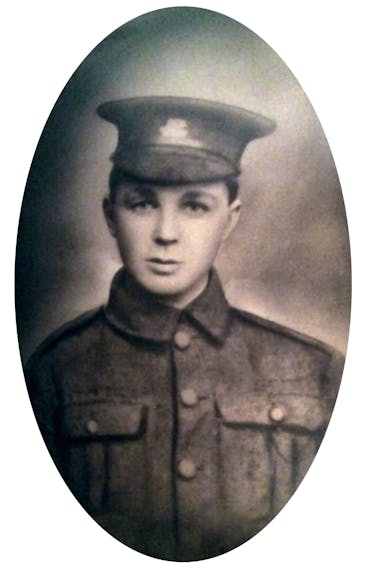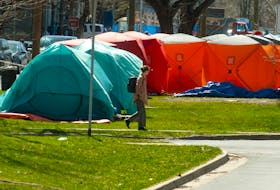ST. JOHN'S, N.L. — After a year of tireless research, provincial archivist Greg Walsh says he feels like he helped bring a Newfoundland Regiment soldier home after the young man’s remains spent almost 100 years beneath the soil in Belgium.
On Tuesday, The Rooms and the Department of National Defence announced that for the first time the body of a Royal Newfoundland Regiment soldier was positively identified through the use of family DNA.
Pte. John Lambert was born in St. John’s on July 10, 1900. Lambert enlisted in the Newfoundland Regiment on Aug. 16, 1916. He lied about his age in order to enlist, claiming to be 18 years and three months old, when he was just 16.
Walsh says because Lambert lied about his age, tracking him down was all the more difficult, but made confirming his identity all the more rewarding.
“It was hard to find him. We had to consult baptism records, we had to consult confirmation records, to be sure it was him,” said Walsh.
“It’s the nature of what we do. Once you look at so many pictures and war diaries of the Regiment, you remember the sacrifice they gave, it’s emotional.”
Walsh says tracking down Lambert is the highlight of his career. He says he’s just happy to provide some closure to the family of Pte. Lambert.
“So many of them have no resting place, no closure, no graves where relatives and friends can go to on Nov. 11 or July 1 — this is one I feel like we brought home,” said Walsh.

Perry Grandy, chair of the Royal Newfoundland Regiment Advisory Council and retired colonel in the Canadian Forces Reserve, says it was common for soldiers to lie about their age in order to enlist.
“There was a lot of child soldiers that served in the (First) World War, and specifically from here. They lied about their age, I don’t know what the youngest one was … but they were as young as 15 years old,” said Grandy.
“Their motivation for it was there was a lot of poverty here in Newfoundland at the time. It might have been a sense of adventure, get away from home and see the world. It’s usually what young men and women join the military for, is to have that bit of adventure. But they were quite young. I don’t have the exact number for how many 16- and 17-year-olds were killed, but (Newfoundlander) Tommy Ricketts, remember, was the youngest Victoria Cross (recipient) in the British Army.”
Two weeks after joining the Newfoundland Regiment, Lambert sailed through the Narrows aboard the SS Sicilian, headed for Ayr, Scotland, to join the second battalion of the Newfoundland Regiment. Lambert helped other soldiers train for battle for almost a year before it was his time to face combat.

On June 7, 1917, he joined the first battalion of the Newfoundland Regiment in Rouen, France, before a British offensive began northeast of Ypres on July 31, 1917.
Lambert waited with the Newfoundland Regiment for over a month for their turn in the fray. The 88th Brigade, which included the Regiment, made up the right flank of an attack on German trenches.
The attack was twice delayed due to heavy rain that soaked the ground and churned up mud on the battlefield. Finally, on Aug. 13, the British forces made the charge out of the trenches.
Newfoundland Regiment soldiers were able to keep up with the artillery barrage covering their attack, and advanced over 1,100 metres to the German trenches. The Regiment overran the German trenches, completing all of their objectives in what would later be known as the Battle of Langemarck.
There were 103 casualties suffered by the Regiment that day, with 27 men losing their lives. Among them was 17-year-old Pte. John Lambert.
On Sept. 29, 1917, a letter was sent to Richard and Michael Lambert of Cuckhold’s Cove Road in St. John’s, informing the family of their son’s death.
Lambert’s name was etched into the Beaumont-Hamel Newfoundland Memorial, to commemorate soldiers lost with no known grave.
In the fields of Belgium, Lambert’s remains laid undisturbed for almost 100 years.

In April 2016, an archeological dig near Langemarck-Poelkapaelle, Belguim, discovered the remains of four First World War soldiers. Among the remains, a shoulder title of the Newfoundland Regiment was found.
There were 13 soldiers whose remains were unknown that could have been the body found in Belgium. Walsh says there were some clues along the way that helped identify the remains.
“Dr. Sarah Lockyear, who I haven’t met because of COVID but I feel like she’s a friend, she knew the remains were younger than what they should be. That was our first clue,” said Walsh.
“That narrowed it down to two. The other moment was when I saw a photograph of him. We had no idea who it was. The photograph, my understanding, was provided to Ottawa on Remembrance Day this year. I saw the photograph for the first time just four or five days ago and that was my other emotional moment. Just to put a face to a name.”
In November 2019, the Department of National Defence’s Casualty Identification Review Board confirmed the remains belonged to Pte. John Lambert.

It is believed Lambert and the other soldiers found with him were buried near the site of a field hospital and for unknown reasons, their remains were not found and recovered following the war.
Lambert’s remains will be buried at the Commonwealth War Graves Commission’s New Irish Farm Cemetery in West-Wlaanderen, Belgium. Soldiers of the Royal Newfoundland Regiment, which carries on the tradition of the Newfoundland Regiment, will be on hand for the burial, to be held at the earliest opportunity. Members of Lambert’s family, representatives from the Government of Canada, the United Kingdom and Belgium, and members of the British, Belgian and Canadian armed forces will make the trip to commemorate Lambert’s sacrifice, at a later date.












